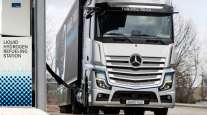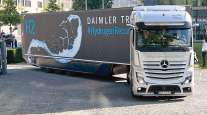Daimler’s Powertrain Chief Oversees Global Integration
REDFORD, Mich. — As head of powertrain and manufacturing for Daimler Trucks, Frank Reintjes plays a critical role in the development of the company’s trucks around the globe. He has been with the company for 20 years, spending time on both the truck and passenger car side.
Based in Daimler’s Stuttgart, Germany, headquarters, Reintjes visited the company’s plant here in late November to celebrate the launch of production of the DT12 automated manual transmission. Also at the event, Daimler Trucks North America announced a $375 million investment to bring production of its Detroit-branded DD5 and DD8 medium-duty diesel engines to the plant in 2018.
Reintjes sat down with Transport Topics to discuss several developments.
TT: How did DTNA prepare for the Redford facility to take over transmission production?
 Daimler AG
Daimler AGReintjes: For two years, the Gaggenau [Germany] people produced these transmissions to prepare the ground, and obviously these people also would have liked to produce it forever and to just export it to the U.S.
But we decided to produce it here, so their task was . . . to support their colleagues who will take it away. That was some of the emotion, at least at the beginning.
But this went on very well, very fast. The teams came together — 14 sub-teams — always twin leads, with one from Detroit and one from Gaggenau.
The launch of the product is, therefore, not only remarkable for fueling [North America], but the global powertrain business unit grew together along this project.
TT: What happens now with the medium-duty engines?
Reintjes: This will be another exercise at our plant in Manheim, which is the home of the engines in Germany. But as [DTNA President] Martin [Daum] said, the DD13 and 15 [engines] were launched here in the U.S. first.
So it’s not [just] a Mercedes engine that has a Detroit [sticker]. Just put it the other way around — [those were] Detroit engines, and three or four years later they were introduced into Mercedes trucks.
More and more people feel that they are part of one global business — the global powertrain business unit — which is obviously the most global one with production locations everywhere around the world.
TT: How much further can you integrate the powertrain?
Reintjes: There are two main levers. The first lever is to improve the single component — the engine, the transmission, the axles. There are a lot of activities in the pipeline.
The second lever . . . is the further integration, which is not that much a hardware challenge as a software challenge.
Specifically, if you take the so-called downspeeding trend, which is use a very fast axle, enable the engine to go down with rpm and the transmission is in between.
This needs very sophisticated management of the single component [that] is done with software that needs, on the hardware side, very intelligent controllers [that] communicate to each other and, obviously, this is the big advantage of our integrated powertrain approach.
Third-party companies — we very much respect our competitors here, Cummins, Eaton, Dana, Meritor — but the complexity to do that all for all the customers for all these different applications is killing them.
And we are simply focusing on our trucks. We know their applications. We know our components. So the effort is not that high, but we are also in a way, self-confident enough to claim that as for the integration of the components we are ahead of others.
TT: How concerned are you about the greenhouse-gas rule in the United States?
Reintjes: I am not a specialist on U.S. emissions regulations, but obviously this is a global trend. Our product plans are long-range plans anticipating future emissions legislation around all the regions in the world. In order to safeguard, we give maximum, common answers to all these different aspects of emissions regulation.
On the other hand we see — and this is different than 10 years ago — emissions regulation is converging more and more [in North America, Europe and Japan]. So this in a way helps globally. In the past it was different.
The test cycles are still very different but the emission levels themselves are more and more standardized.
TT: Are there any governments besides California currently considering tighter requirements on nitrogen oxides?
Reintjes: California is most strict. As for NOx, California might be the strictest in the world.
TT: What does that mean for DTNA?
Reintjes: We have to take that into consideration because, obviously, no longer selling trucks in California is not an option.
In principle, we as a manufacturer support all these environment-protection initiatives.
The question is planning . . . the period from announcement to realization, is that reasonable? Because I can tell you that is really for our engineers, a really tough job.
TT: What is your view on the natural-gas market?
Reintjes: We discussed that a year ago, and we came to the conclusion that we will be prepared, but that the attractiveness of a [natural] gas engine is dependent on the spread of diesel to gas prices.
Both the gas engine and the system of the tanks and valves you have to put is far more expensive compared with a diesel system.
If you consider the payback of the higher initial investment it all plays along the spread of diesel to gas.
So now, compared with year ago, all the enthusiasm is lower but it might come back. It is clearly on the radar.




